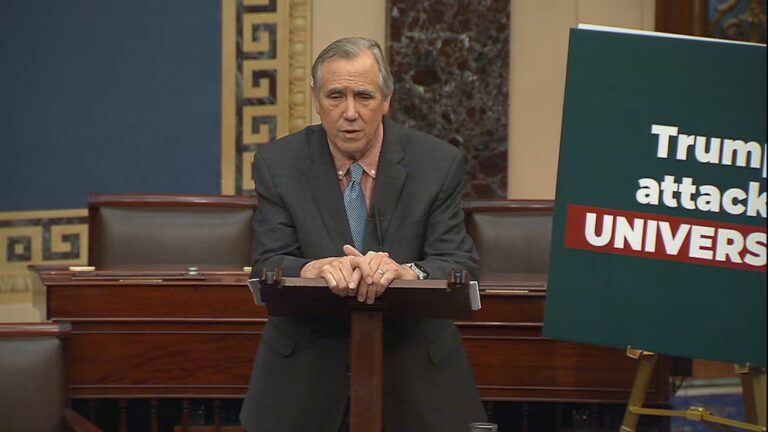
The most striking thing about the much-hyped Texas primaries is how ordinary they actually were.
That was the message from the Texas Tribune’s Evan Smith, who has been following the state’s politics for the better part of three decades, when I spoke with him by phone. At the end of the day, 1.5 million Republicans voted in the primary and 1 million Democrats did. Despite the blue Texas hype and anti-Trump national environment, Republicans held a 500,000-vote advantage once all the ballots were counted.
“Democrats like to say Texas is not a red state, it’s a nonvoting state. Fine. But the fact that it’s a nonvoting state means that it’s a red state,” Smith, the Tribune’s CEO, told me. “At the end of the day, yesterday was more or less a regular Texas election. More Republicans turned out than Democrats.”
Smith is among the skeptics of the blue Texas narrative. Yes, Hispanics might be destined to become a majority in the Lone Star State. But they tend to be less educated and to have a lower socioeconomic status — which are stronger indicators than race of their likelihood of voting.
On top of that, Hispanics aren’t a monolith: More than 40 percent voted for conservative Texas Gov. Greg Abbott in 2014.
“There was this sense that, with Donald Trump coming down that escalator talking about how Mexicans are rapists, Hispanics would be super motivated in 2016 to turn out against Trump, and Hispanic turnout in Texas was only marginally higher,” Smith said. “You have to ask yourself: If they’re not going to turn out against that guy, what’s it gonna take?”
But Smith wasn’t totally down on Democrats after Tuesday’s middling returns. He pointed to the strikingly strong performance of women across the state and the potential for some solid House pickups in the fall. Just don’t count him among the believers that Democratic Rep. Beto O’Rourke can upset incumbent Republican Sen. Ted Cruz in the state’s marquee race this year.
Below is my discussion with Smith, edited for length and clarity.
Dylan Scott
It seemed like there was contradictory data yesterday. Democratic turnout was way up, but Republican turnout was still substantially higher. That seems bad for statewide races, but there were also some good signs for Democrats in competitive House districts. What did you learn last night?
Evan Smith
First of all, the wave was not blue. It was pink. The more interesting outcome of the elections last night was not that Democrats came roaring back. I think there was a misread on the early vote enthusiasm. The assumption was it translated into big Democratic gains in the primary that would set up big Democratic gains in the general.
At the end of the day last night, Republicans had a 500,000-vote lead over the Democrats in terms of primary turnout. What does that tell you? Republicans still have more people turning out to vote than Democrats. Democrats like to say Texas is not a red state, it’s a nonvoting state. Fine. But the fact that it’s a nonvoting state means that it’s a red state.
I believe there are probably enough people who identify as Democrats or progressives in Texas that if they all turned out to vote, you’d have competitive elections. And if I were 6 foot, 8 inches, I’d be playing basketball for the New York Knicks. You don’t live in the world you wish existed; you live in the world that is.
At the end of the day, yesterday was more or less a regular Texas election. More Republicans turned out than Democrats. Was the gap narrowed? Yes.
Dylan Scott
So what was the pink wave?
Evan Smith
All things equal, you would have preferred to have been a woman on the ballot. Women did really well across the state. You’ll have the first two Latina members of Congress from Texas in history: Veronica Escobar from El Paso, Sylvia Garcia from Houston.
You’ve got a woman in the lead of the Democratic primary race to challenge Republican congressman Will Hurd, Gina Ortiz Jones. You’ve got two women in the race against John Culberson, Lizzie Pannill Fletcher and Laura Moser, the candidate the DCCC dumped that oppo on. They basically fucked up that race. If the DCCC had kept its mouth shut, Moser might not have made the runoff.
You’ve got a woman in the second-place slot in the race against Republican congressman Pete Sessions. You’ve got two women in the running in the race to succeed Democratic congressman John Carter. You’ve got a woman in the second slot in the runoff for the Democrats in the old Lamar Smith district. A woman finished in first in the Texas Democratic governor’s primary.
This is a good year for women. You would rather be a woman candidate, all things considered. Half the population of Texas is female. There are three women out of 36 members of Congress. In the Texas legislature, which has 181 seats, there have only been 155 women elected in history. There is only one woman in statewide elected office.
The Texas political universe is older, whiter, and maler than the population it serves. This year, from the standpoint of gender, is looking closer to a correction here.
Dylan Scott
Is there an enthusiasm factor there? Or was it the candidates who were put up this year?
Evan Smith
I think the first enables the second. Candidate recruitment is one of the many problems Democrats have had here for more than 20 years. Well, there’s a lot of enthusiasm on the ground. People are pissed off. Anger is always a greater motivator than joy at election time.
That anger translates into motivation to participate civilly, in theory. The environment created by that energy and enthusiasm in turn enables candidate recruitment. The candidate recruitment by Democrats this year was significantly better than it’s been in a long time. There were many fewer races in the Texas legislature where the Democrats didn’t bother to field a candidate. For the first time in my 27 years in Texas, Democrats fielded a general election candidate in every single congressional race.
Dylan Scott
So where does that leave us? What are the most interesting questions heading into the fall if Texas is not about to undergo a realignment?
Evan Smith
I think there was never a dramatic Texas realignment on the table. I think a lot of people misread the environment and the mood around the country. They saw Virginia. They saw Alabama, Roy Moore and Doug Jones. They saw the state Senate seat in Wisconsin. They thought Texas was the next pebble in the path.
Texas is its own path. Nobody understands that. Texas flies by its own set of coordinates politically. This is not a state that is in line, from a trend standpoint, with other places. This is a place that is a blood-red state. If other states move to the middle, or become more blue, Texas has resisted, resisted, resisted at all turns.
Of course, the demographic indicators would tell you that change is coming at some point. It’s not here yet. Beto O’Rourke, who has been lionized by the national media, is traveling around the state doing all the things; he’s going to places where Democrats don’t typically campaign, he’s raising a lot of money. He was held to below 62 percent of the vote in the primary. He had a woman run against him whom nobody had heard of but who had a Hispanic name, and she got border county after border country.
Dylan Scott
So what explains the resistance to this demographics-as-destiny argument? Is part of it, based on what you just said, that the Democratic Party is a little bit fractured?
Evan Smith
It’s not a Bernie-Hillary thing, although there are definitely races where the Bernie-Hillary thing is playing out. But that’s largely not the issue.
If you talk to most people, they’ll say a problem the Democrats have, or the problem Democrats have, is that Hispanics as a general rule do not vote at the percentage of their eligible vote population to the degree that the Anglo, or African-American, or Asian populations do.
If you talk to James Aldrete, a Hispanic political consultant in Austin, he always says to me: You say Hispanics don’t turn out to vote. But race is not a predictor of turnout. It’s age, education, and poverty level. He would actually say that the Democratic Party is younger, and because of demographic changes, there are a lot of people who would potentially be Democratic voters who are not as well educated. There’s also a question of the socioeconomic [status] of a lot of the people who are new to Texas.
You add all that together: The problem is really an education problem, it’s a poverty problem, and to some degree, it’s an age problem. I can’t argue with him.
Dylan Scott
That makes it sound like some of the structural disadvantages that you might think Democrats would eventually overcome could actually endure. That’s a problem for any dreams of a blue Texas.
Evan Smith
If Democrats say to me, “Wait till the Hispanics are [the] majority and then everything will be fixed,” that assumes, among other things, that Hispanics are monolithic. Gov. Greg Abbott got 44 percent of Hispanics against Wendy Davis in 2014 and outright won the votes of Hispanic men.
Hispanics are not monolithically one party. So the premise is faulty to begin with.
There was this sense that, with Donald Trump coming down that escalator talking about how Mexicans are rapists, Hispanics would be super motivated in 2016 to turn out against Trump, and Hispanic turnout in Texas was only marginally higher.
You have to ask yourself: If they’re not going to turn out against that guy, what’s it gonna take?
Dylan Scott
So, going off everything you know and what we saw last night, what do you think we see in November? What’s your best guess? Ted Cruz wins by 8 points and Democrats pick up some House seats?
Evan Smith
The Democrats have tended to do here what they’ve done elsewhere in the country in places where Democrats don’t typically win: They say if we keep this to single digits, we celebrate. You know what you call a Republican who wins by single digits when Republicans typically win by double digits? Congressman.
The Democrats will not consider the Senate race a victory unless they actually win. Keeping Ted Cruz to an 8-point margin against Beto O’Rourke is not gonna be a victory. Beto O’Rourke will have to work really, really hard to make this race competitive. He’ll need the national environment as an assist. In the absence of the national political environment, you’d have to show me circumstances on the ground here that led me to believe that that race can be competitive enough for him to win.
With the congressional races, it’s different.
The congressional races are going to be determined on the ground in those local markets. To what degree do the Republican members take those races seriously to see they really have a challenge on their hands when they typically don’t? To what degree do the runoffs in those races produce candidates who can win in the fall? What does the national political environment look like?
There are three districts that the Republican incumbent won in 2016 and Hillary Clinton won. There are 10 districts in the Texas House with the same situation, one state Senate seat. Those are gonna be the focus and the targets of the Democrats.
To go back to what we talked about with recruitment, the reason you have so many high-caliber Democrats running is because there’s opportunity made manifest by that outcome in 2016.
Sourse: vox.com






